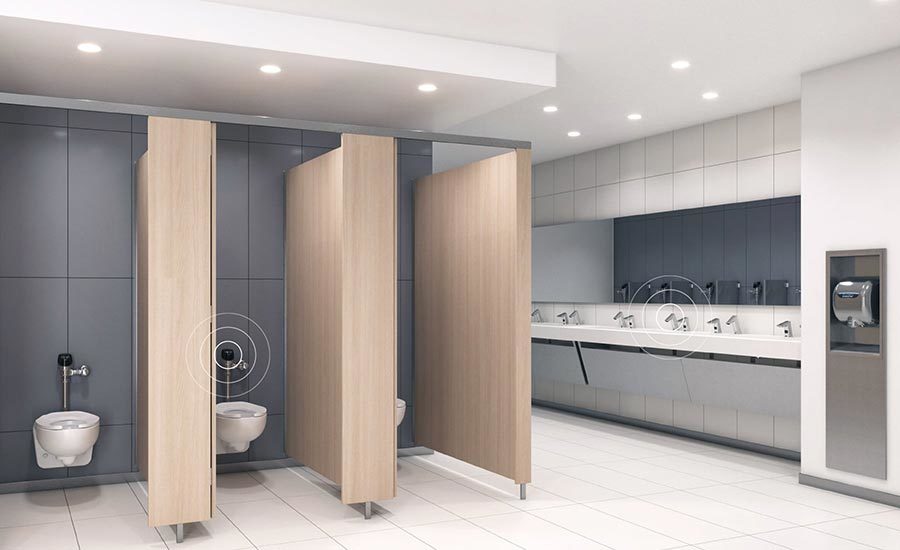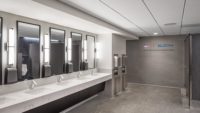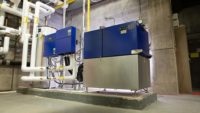When crowds begin to return to commercial spaces, customers will want to enter a restroom where they feel safe. That’s why facilities of all types have been retrofitting restrooms from manual to touch-free operation at a rapid pace over the course of the last year in order to minimize the spread of germs and bacteria.
Health and wellness have become top-of-mind for everyone. This heightened sense of hygienic focus is especially true when it comes to high-traffic areas like the restroom, the second-most visited space in a commercial building. The increased sensitivity to potential contamination is the main reason why sales of sensor faucets are expected to grow 28% by 2024, and sales of all motion-sensing technology is set to grow 37% by 2023.
Science supports the move to touch-free operation and it has been well known that the fewer surfaces guests touch, the less likely they are to spread contamination. Proper hand hygiene remains the single most important activity an individual can undertake to prevent the spread of infectious disease. As a result, “high-touch” restroom surfaces like flush handles and manual faucets are becoming increasingly phased out in favor of sensor-operated technology.
Along the way, health officials and facilities have also realized that customers will wash their hands more often when they feel safe doing so. Having touch-free facilities increases the likelihood that customers will engage in proper hand hygiene and improves potential.
We’ve recently become aware of one of the first documented “super-spreader” events attributed to the use of manual products in a public restroom. In that instance, a number of employees working on the Toei Oedo subway line were stricken with COVID-19 because they shared a single manual faucet in the employee break room. The Toei Oedo subway line is operated by the Tokyo Metropolitan Bureau of Transportation, and prior to the pandemic, had almost a million riders daily. In December 2020 it was reported that 39 subway drivers on the line were contaminated after one person who was ill likely contaminated a manual faucet handle with their saliva while brushing their teeth in the break area. The subsequent illness and number of sick drivers led to a 30% loss in productivity across the 38-station subway line almost immediately.
To rectify the situation the Tokyo Metropolitan Bureau of Transportation publicly committed to converting the restrooms in all 38 of the stations along the line from manual to touch-free sensor operation. Many facilities contemplating the upgrade from manual to touch-free restroom fixtures and fittings are doing so to keep their patrons safer and more comfortable, and to be part of the pandemic recovery solution rather than being identified as the potential source of contamination. Upgrading facilities as quickly and as cost effectively as possible often involves the use of a simple retrofit kit. Let’s take a closer look at the ongoing retrofit trend.
A solution for every type of facility
Sensor-operated restroom technology can be important to customers in any commercial restroom, but the specifications required may vary depending on the facility type. For example, gooseneck faucet spouts are a preferred solution in health care and heavy industrial environments as they allow for handwashing up to and above the elbows for medical professionals as well as workers who deal with dirt and grease on a regular basis. ADA requirements are always crucial in any work or public environment. If users have limited mobility or use of their hands, sensor faucets can allow for easier access. This is particularly true for gooseneck faucets in health care applications.
In high-traffic venues like public transit facilities where the goal is to funnel guests out of the restroom as quickly as possible, touch-free integrated sink systems that place every step of the handwashing process within arm’s reach are a preferred solution. With a sensor-operated faucet, soap dispenser and hand dryer, these integrated sink systems help make the handwashing process more efficient while guarding against water drips on the floor, which can contribute to slip-and-fall incidents.
Educational settings are often prone to student vandalism. Students can at times abuse equipment, while also trying to flood the restroom by intentionally leaving the water running. Touch-free faucets, along with sensor-operated water closet and urinal flushometers, not only promote hygiene in schools, but prevent this problem of water waste, vandalism and flooding. This additional type of water savings can be found on both touch-free faucets and flushometers when compared to their manual equivalents.
Touch-free is no longer high-tech; it’s mainstream.
As recently as the 1990s, a large percentage of the public had no idea what to do when confronted with a touch-free flushometer or faucet. Now, 30 years later, most people take them for granted. Some individuals may even catch themselves placing their hands under a manual faucet and wait for it to turn on automatically. Others don’t bother to flush a public toilet any longer because they expect a sensor to take care of things — often to the frustration of maintenance staff.
Fortunately, retrofits can eliminate these situations and ease the burdens on cleaning and maintenance personnel. Sensor-operated restroom products also come with a number of interesting technological benefits for facilities considering potential retrofits.
Touch-free technology can accomplish more than just effective handwashing. With the Internet of Things (IoT) having made its way into restroom products, faucets are able to store information which enables maintenance teams to remotely diagnose issues. It’s even possible to monitor the percentage of CDC (Centers for Disease Control and Prevention) compliant handwashes taking place within a particular location. “Smart” restroom fittings and fixtures are now making it possible to measure water usage at the actual faucet or flushometer. Facility teams can see which devices are being used and how often, which has incredible implications for scheduling maintenance. It’s one of the key advances expected to help buildings move on from preventative maintenance to the new world of “predictive maintenance.” None of this was possible before sensor-operated products brought power to fittings and fixtures, enabling a host of monitoring and measurements to take place that had never been possible until now.
This type of information is also helping facility maintenance teams to manage their restroom products more efficiently and easily than ever before — all in real-time. For example, the maintenance team at the Vanderbilt University Medical Center is able to remotely monitor each one of its sensor-operated faucets through a mobile app that puts data right at their fingertips. The team is now able to conduct weekly check-ins on specific fixtures and gather data that allows it to measure and report on water usage as needed.
Ushering in a new post-COVID era
Accurate, actionable data is a fundamental ingredient in the recipe for change — and that goes for restroom hygiene as well as public health. Almost 20 years ago, I was personally involved in efforts to support water treatment systems in Hong Kong hospitals during the SARs outbreak. Pure, safe water was needed for drinking, dialysis, medical formulations and a host of critical uses. But due to lockdown, we had no way to get trained service technicians into the facilities and no way to get equipment condition or failure mode data out. Fast forward to several years ago when Sloan started to build IoT capabilities into its sensor products. We did so with learnings from those situations.
Commercial restroom products can now support quarantined facilities, extract relevant technical data remotely, and even help facilities when our own technical support personnel are working remotely. Not bad for something as simple as a retrofit kit.
Eventually, restrooms will be entirely touch-free, from the time you enter to the time you exit. For now, restrooms are effectively working to cut down on those “high-touch” surfaces that make guests uncomfortable and create a space where people feel at ease as they begin to repopulate commercial venues in 2021 and beyond.






